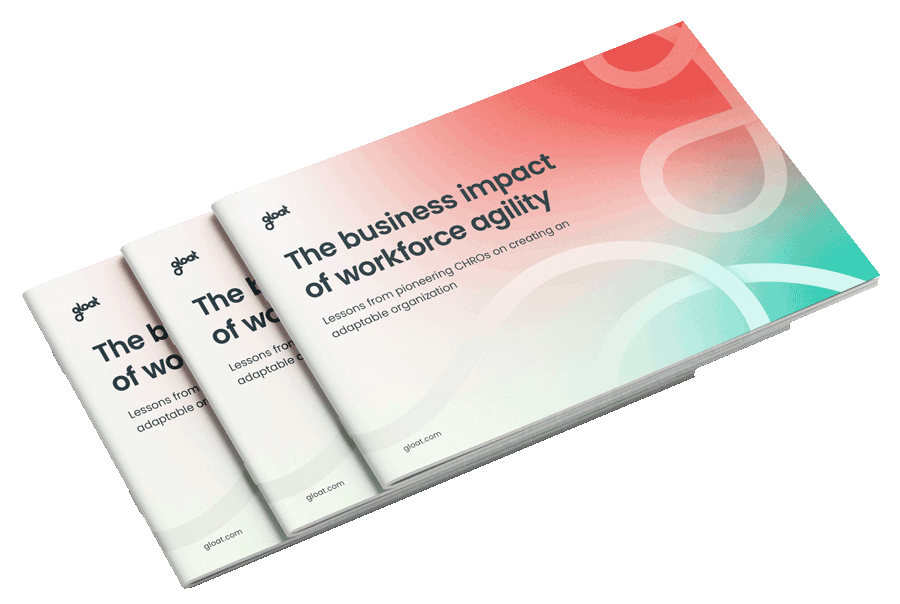How to implement a talent marketplace: 5 best practices

Being the first to launch any kind of workplace technology might feel risky, but when it comes to talent marketplaces, there’s no doubt they’re paying off. The pioneering companies that partnered with us to bring to life the first enterprise-grade platforms are seeing some impressive results. Schneider Electric generated a savings of over $15 million in enhanced efficiency and reduced recruiting costs, while Seagate saw a 58% increase in the participation and assignment of projects to women.
Consequently, it’s no surprise that many organizations are looking to take a page from their playbooks by launching a talent marketplace. Gartner even named implementing a talent marketplace as one of the top three things that CIOs should do to drive value.
While the platforms can put impressive metrics within reach, ultimately your talent marketplace’s success will be determined by your launch strategy. If you’re looking to maximize your platform’s impact, leaders must take the right approach to implement this transformative technology and understand the role it will play in their landscape.
The evolution of talent management: why traditional approaches are insufficient
Traditionally, the dominant way to fill emerging skills needs was through external hiring. Businesses repeated the same lengthy process of attracting and recruiting talent, interviewing qualified candidates, extending offers, and onboarding.
Yet, as the hiring landscape gets more competitive and the pace of innovation accelerates, forward-thinking companies are looking inwards to unlock the capacity they’re looking for without the lengthy applicant search and recruitment process.
Prioritizing internal candidates over external applicants benefits the business in many ways. Organizations save on hiring and onboarding costs, while employees grow more engaged and satisfied with their work experience because they’re given opportunities to expand their roles and build new skills. To facilitate this internal-first talent management approach, savvy business leaders are turning to talent marketplaces. The AI-powered platforms match employees (and their skills) to projects, gigs, mentorships, and full-time roles within their organizations that align with their experience and long-term career ambitions.
What to think about before implementing your talent marketplace
If you think launching a talent marketplace will be just like updating your human capital management platform (HCM), think again. These platforms are an entirely different category of workplace technology, so it’s important to anticipate and prepare for change. In fact, there are 8 questions that you need to answer before finalizing your talent marketplace decision.
In addition to planning the details of your launch and roll-out plan, you need to create a vision for what your integrated marketplace ecosystem will look like. Some questions to consider include “How do you integrate technologies across the ecosystem to create value for the organization?” and “What do you want in your technology stack and how can you create a seamless user experience for your people?”.
If it sounds like a lot to figure out, just think of the benefits that your talent marketplace will help you achieve. Namely, the platforms are a powerful tool for unlocking agility, democratizing access to career opportunities, and empowering your people to reach their full potential. Talent marketplaces are also moving the needle on employee retention during the Great Resignation. As Seagate’s Chief Human Resources Officer, Patricia Frost, explains, “We haven’t seen the Great Resignation at Seagate. The game-changer for us is this journey we’ve been on with Gloat. Employees have their careers in their hands and they can see vertical and lateral movement possibilities.
Building your internal talent marketplace
Before you even choose which talent marketplace vendor you want to work with, keep the following considerations in mind:
#1. Get ready for a mindset shift
Launching a talent marketplace doesn’t just create a technology change; it also drives a profound cultural shift. Instead of viewing talent as “mine”, managers must embrace a shared approach in which resources are continuously reallocated across the organization.
At the same time, employees should feel empowered to take on projects with various teams, giving them more independence and autonomy than they might be accustomed to. It’s up to HR leaders to create a variety of resources to help managers and employees navigate these shifts, including information sessions, mentoring opportunities, and Q&As so everyone can get their pressing questions answered.
#2. Choose between open-platform approaches or one-size-fits-all suites
One of the biggest decisions leaders need to make when launching a talent marketplace is whether they want to rely on a one-size-fits-all suite or go with an open-platform approach that enables them to work with multiple vendors.
Some executives might think that a one-size-fits-all suite will be easier because they might already be using it for their HCM. But different platforms require different expertise and experience, and it’s unrealistic to expect any single vendor to deliver on all fronts. In most cases, a suite vendor will not equally invest in all offerings, meaning that only some of your functionality would be on par with market leaders.
#3. Think beyond talent matching
In addition to connecting employees to open opportunities, your talent marketplace will become a rich source of insights that leaders can use to uncover skill gaps and disparities between employee expectations and business needs. Beyond preparing to launch your platform, get ready to analyze new sets of data that will pave the way for future skill-building conversations and discussions to ensure managers and employees stay on the same page.
5 steps to optimize your talent marketplace implementation
Once you’ve selected which talent marketplace vendor you’re going to work with, prioritize the following best practices for a seamless implementation:
#1. Learn about your talent marketplace vendors’ integration approach
Every vendor has its own approach to integration. Ideally, your talent marketplace service provider will adhere to an open platform approach that makes it easy to bring together every application and tool that you have for employee development. The best providers go the extra mile to integrate with different employee experience apps so employees can seamlessly access development opportunities across your organization through the talent marketplace.
#2. Know who you can turn to when challenges arise
Since technology is evolving and ever-changing, encountering some level of implementation challenge is almost inevitable. Every organization has unique priorities and you need clear roles and responsibilities to make sure your business objectives are met. Ensure your provider supports you with a project plan and understands your objectives and goals. That way, you can work in lockstep to get your marketplace set up and running quickly to start driving results fast.
#3. Prepare your team for change
Talent marketplaces are a disruptive technology, so it’s important to prepare your workforce for change. Your talent marketplace should have dedicated Change and Enablement support to help you create a plan for onboarding and adoption. Prior to rolling out your platform, your people should have an understanding of what’s coming and the role the platform will play in their growth and development. Your provider should support you with tools, templates, and expertise to ensure you have a clear launch plan and ongoing communications to get your marketplace off the ground. Many of our customers created fun promotional videos and knowledge repositories so that employees could start getting familiar with their forthcoming platform before it launched.
#4. Engage your broader team
A talent marketplace is a critical asset not only for HR teams and executive stakeholders, it’s a tool for every business leader in your organization. Your C-Suite, GMs, and other leaders can be your biggest advocates and the biggest beneficiaries of talent marketplace adoption. Take the time to educate other executives and business leaders on how the tool can support them, their teams, and their needs. Establish champions and advocates amongst company leadership to help encourage employee adoption and drive benefits across the entire organization.
#5. Keep an eye on the future
A talent marketplace is just one piece of your workforce strategy. Keep the big picture in mind, and explore the ways you can use your talent marketplace to evolve your holistic approach to talent. How can your marketplace enhance your career development or your skill visibility? Can you tap into talent to help support your emerging HR needs? It’s important to align your long-term planning goals with your vendor’s roadmap and capabilities to help maximize the value of your solution.
Addressing challenges and roadblocks
Every implementation journey inevitably includes a few hurdles, and talent marketplace launches are no exception. To maximize the success of your platform and prevent it from becoming merely an HR tool, leaders should get everyone onboard with their talent marketplace vision. As executives embrace your launch plan, encourage them to share why they’re excited about the platform and spotlight tangible benefits it will help you achieve. Nestlé USA’s CEO even created a welcome video that played during an employee’s first visit to the talent marketplace to build buzz about their new platform.
Leaders should also go the extra mile to get middle managers excited about the rollout. This segment of the workforce can be one of the most difficult populations to engage during your talent marketplace launch, as they may hesitate to let go of top-performing workers out of fear they’re losing control of the transition. It’s critical to brief this group early on and demonstrate how the solution will benefit them by enabling their direct reports to grow and expand their skill sets.
If you’re looking to learn more about how visionary companies like Seagate and Schneider Electric are harnessing these platforms to achieve game-changing results, check out our guide on the business impact of workforce agility.






